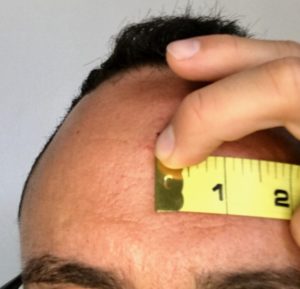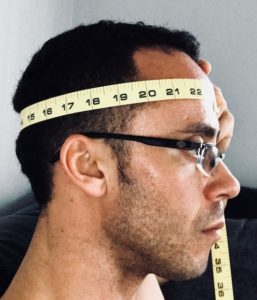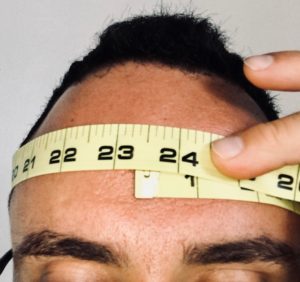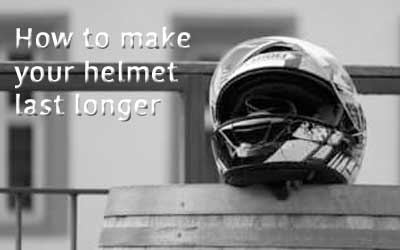Whether you are riding a motorcycle, dirt bike, ATV, snowmobile or another motorized vehicle, it is important to get a helmet that fits you correctly. I created this simple guide to help measure your head and buy the right size helmet.
What size helmet should you wear? This depends on your head measurement and head shape. Head measurement is the circumference of your head at it’s thickest points. Head shape falls into 3 categories: Long oval, intermediate oval, and round oval.
Buying the correct size helmet is absolutely necessary in case you get in an accident. Wearing a helmet that best fits your head size and shape can save your life. This guide will help you determine the which size helmet to get and how to measure your head accurately.
How To Measure Head Circumference
To help you determine whether you should buy a small, medium, or large helmet for your motorcycle, snowmobile, or dirt bike without actually trying the helmet on, you need to take a head measurement. But what exactly is your head measurement and how do you get it?
Head measurement – The measurement of the circumference of your head at its widest points.
Here is a simple step-by-step guide on how to measure the circumference of your head correctly. It is easy to do. Remember to measure your head at its widest or thickest point.
(1) Place tape measure in the middle of your forehead
Start by placing the end of a tape measure tape about a ½ inch directly above the bridge of your nose. It should be resting slightly higher than your eyebrows.

(2) Wrap tape measure around the thickest part of your head
Wrap the tape measure around the middle of your head, above your ears, and all the way around the back of your head so it goes over the occipital bone.

(3) Mark your measurement
Continue to wrap it around the rest of your head until it meets the other end of the tape measure on your forehead. You want to make sure the tape measure remains snug while you take the measurement. You can that my head circumference measurement is roughly 23.5 inches.

It is easy to measure your own head like the way I did in the pictures. However, it may be even easier to have a friend or family member perform the task for best results.
After you get the correct size of your head, it would be a good idea to compare your measurement to the manufacturer’s size chart for an accurate helmet size match. Each manufacturer typically provides their own measurement chart based on the design of their helmets.
General Helmet Size Chart
In case you cannot find it, you can use the chart below to determine what size helmet to get. Note that this is just an estimate of average sizes but should give you a good idea of the size you need to purchase. I’d also suggest looking at helmet sizes above and below your actual measurement because some brands can run smaller or bigger than others.
The chart below displays standard head circumference measurements and corresponding helmet sizes.
| Helmet Size | Inches | Centimeters |
| Extra Small | 20.5 – 21.5 | 52 – 54.6 |
| Small | 21.5 – 22.5 | 54.6 – 57 |
| Medium | 22 – 23 | 55.9 – 58.4 |
| Large | 23 – 24 | 58.4 – 61 |
| Extra Large | 24 – 25 | 62.2 – 63.5 |
If you have a head smaller than the XS mentioned in this chart then you may have to get an XXS, which typically means you have a head circumference the measures less than 20.5 inches. If your head measurement is larger than the XL mentioned on this chart then you might have to look at XXL helmets, which typically means a head circumference of more than 25 inches.
Head Shape
How important is the shape of your head when it comes to the fit of a helmet? Manufacturers to take this factor into consideration when designing helmets so that means it is something you should consider when searching for the perfect size.
Basically, the human head can be generalized into three different shapes. While most heads look the same from the top, they all vary in length and width. Therefore helmets are designed accordingly for maximum protection.
Below I have listed the three common head shapes:
Long Oval: This shape emphasizes an elongated head from back to front and narrower measured side-to-side. The appearance from the front or back appears to be longer than the other head shapes.
Intermediate Oval: This head shape is relatively circular with a wide side-to-side measurement and short front-to-back measurement.
Round Oval: This shape head has a longer measurement side-to-side than the intermediate oval shape. From the front view your head will look more oblong like Stewie’s head from Family Guy. The side-to-side head measurement will be longer than the front-to-back measurement.
Since manufacturers do take head shape into consideration when designing their helmets, it is important to know your head shape so you can get the best-fitted helmet possible.
Wearing the wrong shaped helmet can lead to increased pressure and discomfort while wearing your helmet. Therefore make sure you select the right shape before buying to maximize your overall comfort and safety.
Try It On
The first thing I would recommend before purchasing a helmet for your first time is to go to a store and try it on in person. This way you can get the exact shape and size of the helmet you want.
Manufacturers typically have different helmet sizes compared to brands in their market. Trying multiple helmets on in person is the surefire way to make sure you get a helmet that fits you correctly.
*Tip: Wear it for a few minutes or up to 15 minutes to help you feel the weight and overall comfort of the helmet. After you try it on and write down the exact helmet size and brand, you can later go online and purchase it. Usually, there are better deals on the internet.
How Tight Should A Helmet Be?
Getting the right fit of a helmet can be a little challenging. Of course, you do not want your helmet to be too big and loose or else it will fall off if you get in an accident. Therefore you want it snug. But how tight should it be?
Below I have listed a few simple rules of thumb regarding how tight your helmet should be. You want to make sure your helmet is just snug enough so it does not move but not too tight. If it is too tight then it will be uncomfortable to wear.
This is a good checklist to review when purchasing your first helmet.
- If you can easily pull on a helmet, it is too big. You need to try the next smaller size
- Put the helmet on and fasten all straps. Now shake your head side-to-side then up-and-down. Your helmet should not move. Basically, it should grip the top and sides of your head along with your cheeks and jaw to remain stable. If the helmet does move when performing this movement, the helmet is too big or does not fit your head shape properly.
- When you have the helmet on your head and securely fastened, try lifting it off from the rear base. If it rolls forward over your forehead or start to comes off, it does not fit properly. A properly fitted helmet should not move.
- With the helmet securely fastened to your head, use both of your hands to move the helmet forward and backward then side-to-side. If your skin moves with the lining of the helmet then that means it is a good fit.
- After putting the helmet on, the eye port of the helmet should be sitting snugly above your eyebrows.
- If you can fit your fingers easily between your head and the helmet then it is too big. You need to get the next smaller size helmet.
- You should not be able to rotate the helmet around your head.
- You should be able to see clearly in all directions. Your peripheral vision should not be inhibited.
- Your neck should not be fatigued after wearing the helmet for 10 or minutes.
- Your helmet should remain in place when jumping up and down and when you lean to either side.
These are just a few ways to tell if your helmet fits properly or not. The main takeaway here is to make sure it is snug and won’t fall off if pressure is applied to it.
Bigger is not always better. Do not buy a larger helmet for your child so they can grow into it. For safety purposes, you should buy the helmet size that fits them and then purchase a bigger one as they grow older.
A loose fitting helmet is very dangerous to wear. It should remain stuck to your head. If it can easily be move or rotated around your head, you need a different size.
Key Takeaways
Before you leave the helmet retail store, make sure your helmet fits snugly. Take your time! I recommend trying on at least 3 different helmets. Remember, the fit in the store may feel different than the fit while riding your vehicle. If you can wear the helmet for a test drive, please do so!
Ultimately, there should be very little wiggle room when it comes to an ideal, snug fit. Make note of your head shape and size so you can buy the correct helmet. When buying online consult the manufacturer’s size chart or the one on this page as a supplemental resource. Complete some of the checklist items mentioned in this guide to make sure your helmet fits correctly. If you found this article helpful please share with others.



